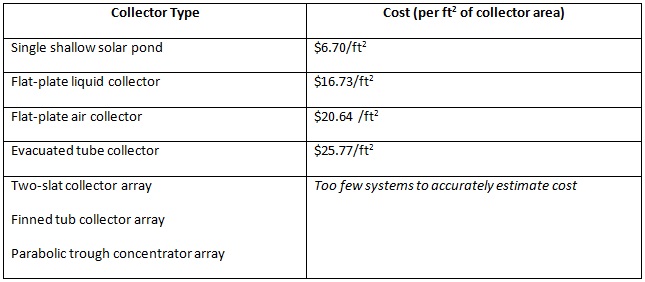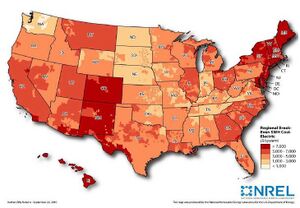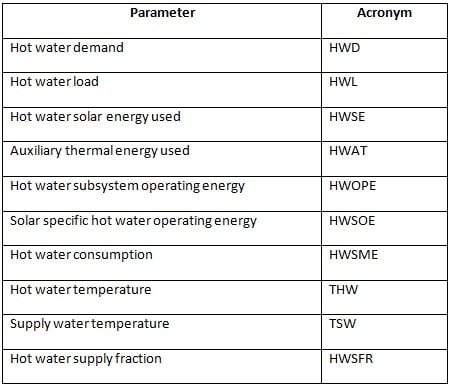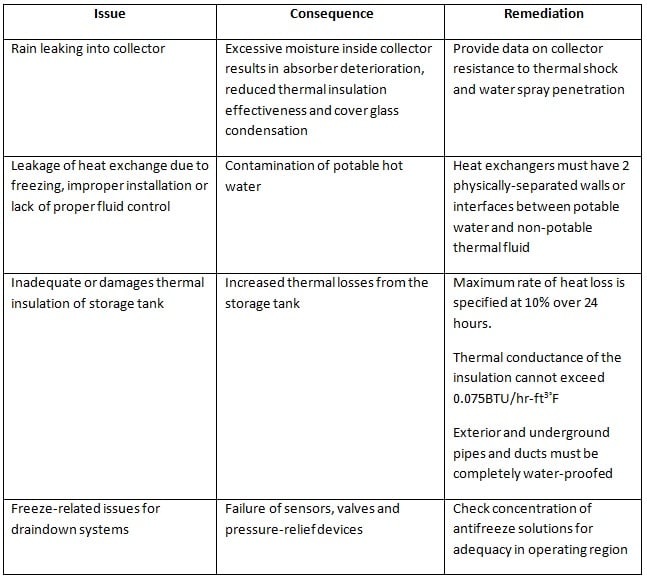Additional Considerations[edit | edit source]
Cost[edit | edit source]
Cost reduction of existing solar water heating systems is essential to achieve a substantial market in the United States. Current system prices are not low enough to gain widespread popularity unless fossil fuel prices increase radically.
The cost of solar heated water systems is a function of system efficiency, solar climate, capital investment and operating costs. Cost considerations can include design and construction costs, life cycle cost or the cost of energy delivered by the system. Many of these parameters are site-specific and thus cannot be easily compared from system to system. Further difficulties arise when trying to quantify highly variable costs such as maintenance and operating costs or variable gains such as tax credits or other tax effects.
A life cycle analysis is the most comprehensive method to determine the most cost-effective system for a particular application. Reliable cost information is difficult to obtain, particularly for residential systems and larger-scale solar thermal systems. Ultimately it is essential that designers can assess cost effects of various design choices prior to design selection.
Cost Estimates by Component [21][edit | edit source]
One way to compare costs from system to system is by estimating component costs; total system cost is then a matter of considering which components were used.
In the textbook "Active Solar Systems," George Lof describes component costs for solar water heating systems. Data on residential component costs is unavailable, however the information for commercial systems can be qualitatively applied to residential systems; system costs will typically be slightly lower than for residential systems due to the concept of "economy of scale." There also may be some regional variation of labor and materials costs.
In general, collector array costs are independent of application and more contingent on collector type. This report found the following information in 1981 for collector array costs.

]
Support structure costs are dependent on site characteristics, collector selection and other functional considerations. In systems where collector rests directly on the existing roof or does not require additional structural elements, support structure costs can be minimal. Little cost variation was observed between roof-mounted and ground-mounted structures; general support structure costs are organized according to collector type, found in Table 10 below.

]
Storage tank costs are expressed in terms of storage capacity and depend on type and location of vessel. Generally, unpressurized tanks are the most inexpensive, followed by fiberglass, rock bins and finally pressurized steel tanks. Buried storage is the lowest cost storage location, followed by external tanks, then internal tanks. Specific cost data for these thermal storage options was unavailable.
Other cost considerations include energy transport costs and sensing and controller costs. Generally, energy transport costs for hot water systems are lower than for steam applications. Controls costs are highly dependent on application, but are generally higher for steam applications than hot water applications. Additional construction costs are site-specific and do not show any identifiable trends.
Cost Estimates by Breakeven Cost [10][edit | edit source]

]
Another method of comparing solar water heating systems is to determine system breakeven cost, which is defined as the point when the cost of energy saved with a solar water heating system equals the cost of conventional water heating. This method of system comparison takes into account all financing and incentives for installation of a solar heating system and discounts benefits of reduced electric and natural gas bills.
One analysis, performed by the National Renewable Energy Laboratory, examines breakeven cost for solar water heating systems in the United States compared to conventional natural gas and electric systems. It was found that the main criteria affecting breakeven cost are fuel price, local incentives and other technical factors such as solar resource, system size and hot water demand; local incentives largely drive the cost-efficiency of solar water heating systems. The highest breakeven costs occur in the southwest, which has a good solar resource, and the northeast where electricity is expensive.
Findings from this study were published in the form of a map where breakeven solar heating system costs is given by location as found in Figure 10.
More generally, breakeven costs can be grouped according to the percentage of homes which could benefit financially from a solar water heating system at a particular price. These results are outlined in Table 11 below.

] As the price of solar water heating systems is reduced, they will become more cost-effective for a wider range of homes. This cost reduction is necessary for widespread application of solar water heating technologies.
Cost Reduction Methods for Cold Climate Systems [8][edit | edit source]
A study performed by Salasovich, Burch and Hilman considers cost reduction methods for solar water heating systems with freeze protection. It was determined that overall system cost can be reduced through the use of lower-cost components, replacement of metal components with polymeric materials and overall system simplification.
The largest cost reduction found was by replacing conventional pressurized solar tanks with unpressurized polymer tanks, achieving cost reductions of up to 17%. The replacement of existing heat exchangers with immersed polymer heat exchangers can achieve cost reductions of up to 9%. While the use of polymeric material can adversely affect system performance, the associated decrease in cost is proportionally more significant.
System Installation and Maintenance[edit | edit source]
Installation, monitoring and servicing of a solar water heating system are as important as proper system design selection. Improper or inadequate attention to these steps contributes poor system performance, accelerated deterioration and eventual system destruction. Published handbooks outline installation guidelines as well as monitoring procedures for a variety of solar water heating systems. A summary of these guidelines are outlined below.
Installation instructions should include step-by-step installation and removal instructions for each system component, as well as relationships between components and interfacing techniques with the physical location of the system. Before the system is put into regular use, system operation and controls should be verified and all piping, valves and connections should be certified leak-free. Instructions should also outline normal and emergency start-up and shut-down procedures, with particular emphasis on critical temperature, pressure and flow values. Any controls, sensors, dampers or valves should be labeled according to function and flow direction to ensure simplified maintenance in the event of an emergency.
A manual detailing routine maintenance should be included in the system, with specific procedures for required maintenance such as periodic component servicing, fluid testing and system flushing. This document should also include information on hazards that may be encountered while servicing the system. Finally, monitoring instructions should be included which detail required procedures to properly monitor the system and instructions for use of simple sensors and indicators which reveal proper system operation.
There are two standardized monitoring methods which have been used in the National Demonstration Program, a government initiative to raise awareness about solar technologies. The first method is known as the National Solar Data Network (NSDN), which analyzes solar water heating systems based on the parameters outlined in Table 12 below.

]
Proper determination of the parameters above allow for simple and accurate system-to-system comparisons.
A second monitoring technique was developed by the Northeast States Solar Water Initiative for systems installed as part of this project. Monitoring objectives are outlined in Table 13 below.

]
This monitoring program is less specific than the NSDN system, however the required information can be collected more easily through simple instrumentation and manual data logging. The most pertinent limitation of this program is its inability to determine heat loss by component. Again, results can still be applied qualitatively.
Residential System Monitoring[edit | edit source]
While the monitoring programs outlined above are useful for large-scale solar water heating system monitoring, there are more simple techniques which can be employed at home to ensure proper functionality of a solar water heating system.
First, it is important that the owner is educated on proper functionality, maintenance and servicing of their system. The user should be capable of troubleshooting routine issues such as collector cleaning and snow removal, and of recognizing signs of more critical issues such as system boilover or back-siphoning which can cause system freezing. One additional concern is that new home owners may lack expertise or interest in a system previously installed in their home.
Residential systems should include accurate and easy-to-ready instrumentation for temperature, pressure, flow and component-specific energy use. Sensors, controllers and valves should be periodically inspected to ensure proper functionality and avoid issues due to improper sensing. In indirect heating systems, there may be an occasional need to add glycol due to leakage or high levels of acidity. Also, solar-heated water can be much hotter than conventional domestic hot water. One method to remedy this issue is through the use of a tarp or sunscreen to cover the solar collector when delivery temperature exceeds what is comfortable for the user. Finally, the system should be prepared for periods of non-use (such as vacations) to avoid system overheating.
Other issues widely encountered with residential solar water heating systems are outlined in Table 14 below, along with why these issues are a concern. The repeated instances of these issues have led US Department of Housing and Urban Development to provide specified residential solar water heating system requirements for all residential solar water heating systems.

]
Through the guidelines outlined above, proper maintenance and monitoring of a residential solar water heating system can be more easily completed. As more installation experience is obtained, fewer issues will be encountered during implementation of solar water heating systems.
Commercial System Monitoring[edit | edit source]
In general, commercial solar water heating systems have similar issues to those encountered with residential systems. Because commercial systems typically require more complex controllers than residential systems, additional areas of concern include controls, sensors, freezing and collector or collector array distribution. While many of these issues can be resolved more quickly than in the past, obstacles remain with probe accuracy, tracking accuracy, optimum differential offset and hysteresis.
Demonstrations and Dissemination[edit | edit source]
Solar water heating system design development has been largely completed by the solar industry, as government support has traditionally focused on demonstration and performance evaluation techniques. This is in contrast to the majority of other solar technologies which have evolved mostly due to government funded research and development and tax subsidies for "green energy" users. Federal funding designated towards solar water heating system design has been limited to materials development, component development, controls and other non-engineering aspects.
One program, the National Solar Water Heater Workshop, was developed in Tempe, Arizona in 1974. The 10 year project was started by Stanley Mumma with federal funding with the intention of establishing staff, working through technical aspects of solar water heating, creating workshop execution plans and preparing documents for the project. The purpose of the project was to project the importance and relevance of solar water heating technologies to universities and the public via the development of a system that could be installed in residences nation-wide.
Currently, the NSWHW program is no longer running and many of their installed systems are no longer in operation. Despite the termination of the program, it has illuminated some important realities of the solar water heating industry. Solar water heating system components should be function for 30 or more years; damage to components is generally the result of operator error. It is speculated that system longevity is limited by lack of market and service sector rather than usefulness and cost-effectiveness of current systems.
Currently, governments use three basic instruments to support renewable energy technologies. The first is tax and market-based incentives, which have been widely implemented in the United States and largely drive cost-effectiveness of current systems. Environmental regulations have also been implemented to reduce the use of fossil fuels in the commercial sector. Finally, direct expenditures have been directed towards the development of renewable technologies, however this is less applicable to the solar water heating industry. For a substantial market to exist, these tools must be applied to positive externalities of technology development, environmental benefits, R&D and demonstration projects, and general program preparation, education and training. [2]
Other groups promoting solar technologies are industry organizations and non-governmental organizations (NGO's) associated with energy efficiency or environmental concerns. For the future, it will be increasingly important to consider new markets for renewable energy technologies, requiring increased decision-making and participation from a variety of stakeholders.
To the Future[edit | edit source]
Future Expectations[edit | edit source]
Some people expect marketing and distribution costs of solar water heating systems to go down, however current manufacturers do not consider such changes to be likely. Because a sacrifice in product quality is a deterrent to the purchase of solar water heaters, increased prices continue to be a reality. While there are fewer marketing and distribution costs, solar water heaters are simply not competitive without subsidies, tax benefits and other incentives. Despite these realities, it is expected that commercial manufacture and sale of solar water heaters, primarily in the residential sector, will continue at current levels. One hope is that solar energy construction costs will be reduced as the benefits of experience in design and installation of solar components are available. Improvements in product quality will lead to greater system reliability, appeal and user confidence; reducing marketing costs and increasing overall demand.
In general, it is estimated that as energy industry regulations increase, further competition will validate previous investments in renewable energy technologies. This, combined with the potential for cost reduction, will greatly expand the market beyond where it is today. As more developing countries introduce their own environmental policies on fossil fuels, the environmental advantages of solar technologies will be more widely applicable. Ultimately, however, more workable and focused policies are required to drive development of these systems, both to increase their appeal as well as to reduce future uncertainties associated with fossil fuel consumption [2].
Applications in Developing Communities [23][edit | edit source]
One exciting application for solar water heating systems is their use in developing regions where a consistent supply of hot water is otherwise unavailable. As technologies and public policy mature, these systems will be increasingly realistic for sustainable development applications. Donor programs are taking more market-based approaches to respond to local demands, increasing the likelihood of long-term success. Ultimately, however, success is contingent on new business models, rural entrepreneurship and other subsidy advantages coupled with increased emphasis on social benefits.
Hot water for residential and commercial uses can be cost-effectively provided to developing regions using solar water heating technologies. Currently 2/3 of all systems are installed in developing countries, especially in China, Egypt, India and Turkey. Many of these markets are driven by government requirements, however in general solar water heating systems can be effectively implemented in areas which are already undergoing development as energy technology is integrated with other changes.
The most important factor for system implementation in developing regions is the required behavior changes required by the user after implementation. Many development agencies have promoted small-scale renewable energy technologies, but most projects fail due to poor technical performance and limited sustainability based on user needs and local conditions. Issues also arise with cost, availability of system components and system maintenance.
It is difficult to quantify the impact of renewable energy technology implementation in developing areas. It is clear that implementation of solar water heating systems in these areas provide significant social benefits and an improved quality of life, however economic benefits are less clear. As experience with productive uses of renewable energy is increased, sustainable implementation of these systems can be improved.
Re-design Considerations[edit | edit source]
Because of the maturity of solar water heating technology, it is difficult to suggest "quick" changes to systems to improve system functionality. Instead it is more pertinent to be aware of available technologies and compatibility based on specific application. While solar water heating offers a reliable, sustainable method to reduce fossil fuel use, success ultimately depends on proper system selection, installation and maintenance. As design evaluation and validation methods improve, this technology can have a wider and more practical positive impact on our global society.
Conclusion[edit | edit source]
Reliable and sustainable energy sources are required because current consumption of energy cannot be sustained. The current use of energy is responsible for greenhouse effect, acid rain and other negative impacts on public health and the environment. The impacts of renewable energy can reduce these effects and help to slow the inevitable consumption of earth's remaining fossil fuels.
Solar water heating provides a feasible alternative energy technology to replace fossil fuel-power conventional water heating methods. There are an estimated 10EJ of global energy potential for solar water heating applications, however current use is limited to approximately 2.2% of this potential [27].
Current system limitations such as freeze protection, reliability and cost in particular will continue to hinder the market until significant cost reductions are achieved. Generally, the appeal of solar water heating is currently limited to motivation by incentives besides cost, such as emission reduction or use of "green" technologies.
Works Cited[edit | edit source]
[1] Altman, Manfred. Conservation and better utilization of electric power by means of thermal energy storage and solar heating. Philadelphia: University of Pennsylvania, Towne School of Civil and Mechanical Engineering, 1971. Print.
[2] Anderson, D. (1997). Renewable energy technology and policy for development. Annual Review of Environment and Resources, 22(15435938), 187-187. Retrieved from http://search.proquest.com/docview/219889969?accountid=28041
[3] Asif, M., & Muneer, T. (2006). Life cycle assessment of built-in-storage solar water heaters in Pakistan. Building Services Engineering Research & Technology, 27(1), 63-69. doi:10.1191/0143624406bt141tn
[4] Atkinson, G., & Colvin, T. (2009). Solar hot-water heating system. ASHRAE Journal, 51(9), 44-50,53. Retrieved from http://search.proquest.com/docview/220474118?accountid=28041
[5] Baylin, Frank. Low Temperature Thermal Energy Storage: A State-of-the-art Survey. Golden, CO: Dept. of Energy [Office of Energy Technology], Solar Energy Research Institute, 1979. Print.
[6] Beckman W. and Bradley D. (2000) Three-season Operation as a Method of Freeze Protection in Solar Domestic Hot Water Systems. In NREL Subcontract Report for Subcontract ZDC-8-17675-08.
[7] Boyle, Godfrey. Renewable Energy. Oxford: Oxford UP in Association with the Open University, 2004. Print.
[8] Burch, J., J. Salasovich, and T. Hillman. "Cold-Climate Solar Domestic Water Heating Systems: Life-Cycle Analyses and Opportunities for Cost Reduction." National Renewable Energy Laboratory (2005). Print.
[9] Burkhardt, J., G. Heath, and C. Turchi. 2011. Life Cycle Assessment of a Parabolic Trough Concentrating Solar Power Plant and the Impacts of Key Design Alternatives. Environmental Science & Technology. 45: 2457–2464. http://dx.doi.org/10.1021/es1033266
[10] Cassard, Hannah, Paul Denholm, and Sean Ong. "Break-even Cost for Residential Solar Water Heating in the United States: Key Drivers and Sensitivities." National Renewable Energy Laboratory (2011). Print.
[11] Duffie, John A., and William A. Beckman. Solar Engineering of Thermal Processes. Hoboken, NJ: Wiley, 2006. Print.
[12] Gamage, J., & Zhang, Z. (2010). Applications of photocatalytic disinfection. International Journal of Photoenergy, (1110662), n/a. Retrieved from http://search.proquest.com/docview/855956756?accountid=28041
[13] Gilbert, John. "There Is Greater Potential from Solar Energy at Higher Latitudes." Architects Journal (2006). Print.
[14] Golob, Richard, and Eric Brus. The Almanac of Renewable Energy. New York: H. Holt, 1993. Print.
[15] Gordon, Jeffrey R. "An Investigation Into Freezing and Bursting Water Pipes in Residential Construction." GreenBuildingAdvisor.com. University of Illinois Urbana-Champaign, 1996. Web. 23 Apr. 2012. <http://www.greenbuildingadvisor.com/blogs/dept/green-building-blog/jeffrey-gordons-paper-bursting-pipes>.
[16] Harvey, Leslie Daryl Danny. A Handbook on Low-energy Buildings and District-energy Systems: Fundamentals, Techniques and Examples. London: Earthscan, 2006. Print.
[17] Juanicó, Luis. "A New Design of Roof-integrated Water Solar Collector for Domestic Heating and Cooling." Solar Energy 82.6 (2008): 481-92. Print.
[18] Klapp, Jaime, Jorge L. Cervantes-Cota, and José Federico. Chávez-Alcalá. Towards a Cleaner Planet: Energy for the Future. Berlin: Springer, 2007. Print.
[19] Kulkarni, G., S. Kedare, and S. Bandyopadhyay. "Determination of Design Space and Optimization of Solar Water Heating Systems." Solar Energy 81.8 (2007): 958-68. Print.
[20] Kumar, Atam. "Novel Design Concepts in Solar Water Heating." Solar Water Heating Systems: Proceedings of the Workshop on Solar Water Heating Systems (1986): 337-45. Print.
[21] Löf, George. Active Solar Systems. Cambridge, Mass. [u.a.: MIT, 1993. Print.
[22] Lunde, Peter J. Solar Thermal Engineering: Space Heating and Hot Water Systems. New York: Wiley, 1980. Print.
[23] Martinot, E., Lew, D., Moreira, J. R., & Wamukonya, N. (2002). Renewable energy markets in developing countries. Annual Review of Environment and Resources, 27(15435938), 309-309. Retrieved from http://search.proquest.com/docview/219881326?accountid=28041
[24] Metal roofs as solar collectors. (2005). Energy Design Update, 25(2), 1-3. Retrieved from http://search.proquest.com/docview/219443716?accountid=28041
[25] Meyer, J. P. (1999). Domestic hot water consumption of the developed and developing communities in South Africa. ASHRAE Transactions, 105(00012505), 173-173. Retrieved from http://search.proquest.com/docview/192553904?accountid=28041
[26] Mumma, Stanley A. "Over Thirty Years of Experience with Solar Thermal Water Heating." American Society of Heating, Refrigerating and Air-Conditioning Engineers, Inc. 117.1 (2011): 57-63. Print.
[27] Pillai, Indu R., and Rangan Banerjee. "Methodology for Estimation of Potential for Solar Water Heating in a Target Area." Solar Energy 81.2 (2007): 162-72. Print.
[28] Quaschning, Volker. Understanding Renewable Energy Systems. 3rd ed. London, UK: Earthscan, 2005. Print.
[29] Salasovich, Jim, Jay Burch, and Greg Barker. "Geographic Constraints on Passive Solar Domestic Hot Water System Due to Pipe Freezing." Solar Energy 73.6 (2003): 469-74. Print.
[30] Sen, Z., Sahin, A.D., 2001. Spatial interpolation and estimation of solar irradiation by cumulative semivariograms. Solar Energy 71 (11), 11– 21.
[31] Sioshansi, Ramteen & Denholm, Paul. The Value of Concentrating Solar Power and Thermal Energy Storage. National Renewable Energy Laboratory, Feb 2010. Web. 26 Feb. 2011. <http://www.osti.gov/bridge>.
[32] Smyth, M., and H. Skates. "A Passive Solar Water Heating System for Vineyard Frost Protection." Solar Energy 83.3 (2009): 400-08. Print.
[33] Smyth, M., P.C. Eames, and B. Norton. "A Comparative Performance Rating for an Integrated Solar Collector/storage Vessel with Inner Sleeves to Increase Heat Retention." Solar Energy 66.4 (1999): 291-303. Print.
[34] Tsilingiris, P. T. "Design and Performance of Large Low-cost Solar Water Heating Systems." Renewable Energy 9.1-4 (1996): 617-21. Print.